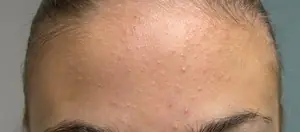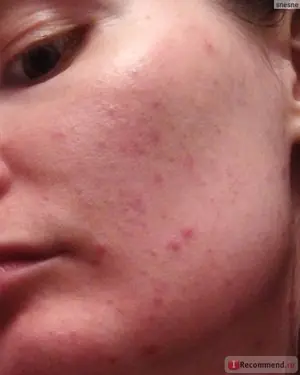
It is known that a rash on the face often forms in adolescents during the period of hormonal changes. But adults also face this unpleasant phenomenon. Rashes can be of various etiologies, are short-term or disappear after some time. There are also types that require contact with a specialist in order to identify or exclude more serious diseases.
Common causes of rashes
Adults should not ignore facial rashes, as the causes can be quite serious. You should not assume that the rash is completely harmless and may go away on its own after some time. The smart human body gives a signal of failure in this way. Therefore regular masking the rash Using tonal products will only temporarily alleviate such an unpleasant situation.
It is imperative to identify why the rash appeared on the face in order to eliminate it in the future. To do this, you need to seek help from a specialist who will prescribe appropriate treatment for rashes on the face of an adult. The most common reasons for their appearance are:

Nervous breakdown. Conflict situations, constant stress, and strong emotional experiences can provoke a rash on the face. The reason for this lies in the action of adrenaline and vasopressin, which are intensely produced in the human body in a state of nervous shock. The rapid release of such hormones disrupts the normal blood flow to the skin, and the skin, in turn, does not receive the required amount of nutrients.- Poor quality cosmetics. It is very common to see rashes on the face of adult women. The reasons for this lie in the use of low-quality cosmetics. Harmful substances are found not only in cheap cosmetics; even expensive brands sometimes cause irritation and rashes. Some facial skin care products contain mineral oils, which create an invisible film on the surface of the skin. This film clogs the pores, limiting air access. In parallel with this, a rapid growth of pathogens begins that cause inflammation. That is why, when choosing cosmetics, it is best to buy one that contains natural ingredients: vegetable oils and glycerin.
- Allergic products. Allergies are a very common cause of facial rash in adults. The list of allergens includes animal hair, plant pollen, medicine or cosmetics. Often inflammation and itching are provoked by certain foods or their components. If you are prone to allergies, you need to pay attention to the quality of the products and also avoid eating citrus fruits, sweets and eggs. During an allergy, the skin begins to swell, itch, and the disease may manifest itself as watery eyes.
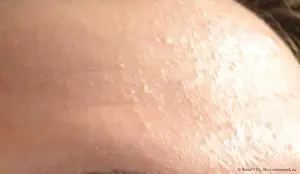
Rashes due to illness. The formation of a rash on the face is accompanied by some infectious diseases, for example, scarlet fever, chickenpox, rubella or measles. This is one of the most dangerous causes of skin rashes. Redness and pimples appear on the face as a result of poor functioning of the gastrointestinal tract.- Infestation with parasites. Sometimes parasites living under the skin can trigger rashes on a person’s face. For example, during infection with worms, a person’s face becomes covered with a small rash. Quite often, such rashes are confused with urticaria. The rash is accompanied by the appearance of spots that are itchy and red. Over time, the spots can turn into bursting blisters. Sometimes eczema forms on the skin, the skin begins to peel, and ulcers appear. In this case, it is imperative to undergo an examination and identify the main cause of the formation of unpleasant symptoms.
- Hormonal disbalance. An imbalance of hormones in the human body disrupts the normal course of the menstrual cycle and the development of diseases of the female genital organs. Thanks to this, the female body reacts with the formation of characteristic rashes. If an adult woman develops acne on her face, this indicates problems in the sexual sphere. The cause of this disease may also be menopause, because because of it, hormones begin to go out of their usual rhythm, which in the future leads to skin diseases.
- Low level of hygiene. Failure to comply with personal hygiene rules can lead to the formation of pimples, blackheads and pustules on the face. That is why it is necessary to pay due attention to the skin of the face, thoroughly cleansing it of dust and dirt accumulated during the day. Don't let your pores become clogged. Currently, modern cosmetology can offer many different options for facial skin care. Traditional recipes for cleansing the skin are still relevant.
- Burns of various origins. The most common type of burn on the face is sunburn. If a person is exposed to the scorching rays of the sun for a long time without a hat, his face begins to turn red, itching and a small rash appear. A sunburn is similar to a heat burn. Due to non-compliance with safety precautions, a chemical burn may occur when using products that contain acids and aggressive substances. If the causes of a rash on the face of an adult lie in damage to the skin due to a burn, then in this case superficial treatment is used with the help of creams and ointments.
In addition to these reasons, there are several other unfavorable factors that can lead to rashes on the face. These factors include:
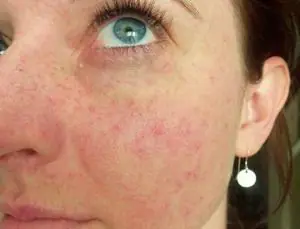
Excess or lack of vitamins. In the cold season, when there is no sunlight, the human body is in dire need of vitamin D. In addition, fluctuating temperatures can negatively affect the condition of the skin. That is why in the cold season it is necessary to take multivitamins, but at the same time we must remember the golden mean, avoiding an excess of nutrients in the body.- Eating fatty, salty and fried foods. Such food, as a rule, has a bad effect on the intestines, which can ultimately result in the formation of rashes on the skin of the face and even on the tongue.
- Bad habits. Drinking alcoholic beverages and smoking are harmful to human internal organs, the condition of which affects the condition of the skin.
- Potent medications. If you take certain medications for a long time and without control, a red rash may form on the tongue and face.
- Skin infections. When infected with streptococcus or other harmful microorganisms, the skin around the mouth is affected.
It is worth paying attention to the fact that the shades of the rash are most often red or pink. If a white rash has formed, this may indicate the appearance of lichen or vitiligo. Vitiligo is incurable and is very sensitive to sunlight and damage.
Features of localization and size of the rash
Of course, a rash on the face cannot occur in an adult for no reason. As you can see, the reasons can be very diverse. Experts have identifiedthat the formation of a rash in certain places is not random and will help you find out which organ is not working correctly:
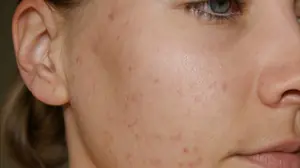
A rash on the cheeks and cheekbones indicates gallbladder dysfunction.- Rashes on the chin indicate the presence of a disease of the genital organs.
- Pimples in the ears are a signal of poor immunity, as well as constant colds.
- Localization of the rash around the oral cavity indicates a malfunction of the gastrointestinal tract.
- Swelling of the eyelids indicates impaired renal function.
- A yellowish tint to the proteins indicates adrenal disease.
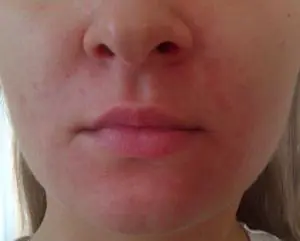
But these statements are not considered fundamental. If red rashes on the face of an adult do not go away on their own for a long time and grow, you need to go to the hospital for advice from a specialist. This is especially true if the rash affects the tongue or lips. After all, this may indicate the presence of an infection, which in the future may spread throughout the mucous membrane.
If you have acne on your face, this stage of the disease can be established simply by counting their number. Up to 10 pimples indicate the initial stage of the disease; external treatment will be sufficient. Up to 40 pimples indicate the second stage of the disease; they are treated both externally and internally. More than 40 pimples indicate a severe stage of the disease. External treatment will not bring any results here. It is necessary to influence from the inside, taking special medications.
Risk group
A facial rash can affect absolutely anyone for one reason or another. But there are still categories that are more often exposed to such an unpleasant illness.
Teenagers aged 16 to 18 years suffer from the appearance of acne on the forehead, bridge of the nose, and cheeks, since it is at this time that hormonal changes begin in their body. Women over 45 years old experience a rash on the skin of the face due to the gradual decline of the ovaries, as well as due to the onset of menopause. People suffering from diseases of the gastrointestinal tract and other internal organs are also susceptible to the formation of a rash on the face.
If a person belongs to one of these categories, then it is necessary to pay special attention to the skin and internal organs. It is recommended to eat properly, eliminating all harmful foods, monitor skin hygiene by cleansing it daily, and also consult with a specialist and follow his recommendations.
Treatment methods at home
Before starting treatment, it is necessary to identify the main cause of the rash on the nose of an adult or on another area of the face. Only then will the treatment be effective and correct. When talking about how to fight and what to do with a rash, you can use both medication and traditional methods of treatment. Traditional recipes for treating skin rashes:
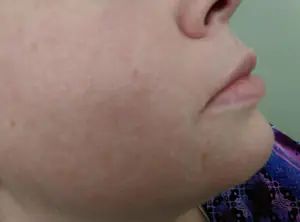
Aloe. This well-known plant can significantly improve the condition of the epidermis. To do this, you need to wipe clean skin with a plant leaf, which must first be peeled, twice a day. Oily and porous skin needs to be wiped with an aloe-based alcohol tincture. To do this, you need to mix four parts of fresh juice with one part of vodka.- Alcohol tincture of calendula. This tincture dries out acne well and removes scars. To prepare the tincture, you need to take 2 tablespoons of flowers and pour 100 ml of vodka over them. The tincture is kept for a week in a dark place, after which it must be strained and the resulting product lubricated the skin three times a day.
- Calendula and honey. This ancient recipe is effective in eliminating inflammation. You need to mix two tablespoons of calendula tincture and honey with a glass of water. The resulting product is wiped over the skin of the face 2 times a day.
- Ice made from chamomile flowers. This remedy eliminates redness and also clears up acne. To make ice, you need to pour one tablespoon of dried flowers into 100 ml of boiling water. When the broth has cooled, pour it into an ice tray and put it in the freezer. Before going to bed and after waking up, wipe your face with ice cubes.
In combination with folk remedies It is recommended to use medications from the pharmacy. In this case, different means are used, depending on the main cause of the rash on the face:
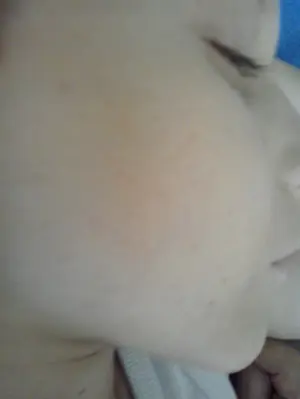
If the cause of the rash on the face is an allergy, first you need to avoid contact with allergens. Tavegil, Diazolin, Suprastin or Loratadine are taken as antihistamines.- If the rash was caused by infectious diseases, then, in addition to antipyretic drugs, a solution of manganese or brilliant green is used.
- If areas on the face have been affected by the herpes virus, then they should be lubricated with Acyclovir cream.
- For sunburn, Pantesol or Panthenol creams are used.
Under no circumstances should you touch the rash with your hands. If you damage the top layer of the blister, new microorganisms will enter the source of inflammation and only worsen the situation. You should also not squeeze out purulent pimples and blackheads. If this does happen, they should be immediately lubricated with brilliant green and a disinfectant.
Redness of the skin on the cheeks can be caused by various factors. The degree of skin damage can vary significantly depending on the individual characteristics of the body. The most common cause of red cheeks is allergies. As a rule, the pathology is more common in children, but many adults also suffer from this disease.
Types of allergic reactions
Allergy-related redness on the cheek of an adult can be caused by various factors. Doctors identify the following types of allergic reactions, which cause irritation on the face in the form of red spots of varying sizes:
- Respiratory. Most often, it appears in the spring or autumn seasons. Pollen from various plants and poplar fluff act as irritants.
- Contact. This type of allergy develops when allergens come into direct contact with the skin. Women are the most likely to experience contact allergies. Red spots appear on a woman’s face as a result of using low-quality, expired or unsuitable cosmetic products.
- Food. Food acts as an irritating factor. The manifestation of allergies depends on the individual characteristics of the human body. The initial sign of a food allergic reaction is usually irritation of the skin on the face in the form of red spots.
Experienced specialists are able to draw a conclusion about the type of allergen based on the type of rash. The rashes that appear are divided into primary And secondary.
The primary ones include:
- Papule. They are nodular formations that manifest as swelling and redness above the skin. Pressing the nodules causes them to change their color to white. The size of papules can vary from three to thirty millimeters. The smaller their size, the more painless the allergic rash goes.
- Pustule. It is a purulent manifestation that occurs in severe forms of the disease. A purulent core forms inside the resulting rash. When you click on it, the color scheme does not change. Pustules are divided into superficial and deep. After deep pustules, scars form on the skin.
- Urtica. On the skin in the cheek area they form in the form of blisters. At the site of their formation, severe burning and itching is observed. As a rule, blisters deflate within one day. Subsequently, peeling of the skin is observed.
- Vesicle. It is a formed tubercle filled with clear or pinkish liquid. The size of the tubercle does not exceed ten millimeters in diameter. Involves separation of the skin due to an allergic reaction. As a rule, vesicles are formed from a contact type of allergy.
Types of secondary rashes are divided into the following varieties:
- Scab. Formed as a result of prolonged exposure to an allergen. It is dried crusts on the skin, which are formed as a result of dead skin cells.
- Flake. It is the result of the disappearance of the primary signs of an allergic reaction from the skin. The scales have a yellowish or grayish tint. Their size can range from one to five millimeters.
- Erosion. It is a consequence of the secondary manifestation of primary signs of allergic redness of the cheeks in adults. Under the influence of erosion, deep damage to the skin occurs.
Based on the symptoms arising from an allergic rash on the cheeks in adults, an experienced specialist can draw a conclusion about the course of the disease. When observing any primary rashes, a preliminary diagnosis is made about the subacute course of the pathology, the presence of various types of allergens or the presence of an infectious component.
To make a correct diagnosis, you need to consult a specialist. They are studying the type of allergen that caused the redness on the cheeks. For this purpose, laboratory tests are prescribed.
When secondary rashes appear, specialists make a conclusion about the chronic course of the pathology.
Methods for treating cheek allergies in adults
There are various methods of treating allergic redness on the cheeks. These can include medicines and recipes from traditional healers. You should not neglect the pathology - this will avoid the development of complications. Treatment should be carried out as prescribed by a doctor.
The use of traditional therapy is aimed at curing the direct causative agent of the disease. Subsequently, medications are prescribed to restore the skin. Depending on the allergen that caused the redness, the following medications are prescribed:
- to eliminate itching - Zyrtec, Suprastin;
- for the treatment of gastrointestinal tract infections - Polysorb, Polyphepan;
- to suppress an allergic reaction – Erius, calcium gluconate;
- topical preparations - corticosteroid ointments, Zinocap, Elokom.
Important! Taking medications should be combined with following a hypoallergenic diet.
The use of traditional methods of treatment helps eliminate the symptoms of an allergic rash. For this purpose, various recipes are used for making masks, ointments and compresses.
Folk remedies
The most popular recipes for removing redness from the cheeks are:
- The affected area is treated with aloe juice twice a day. To do this, take an aloe leaf and cut it in half lengthwise.
- Tincture of seventy percent alcohol and propolis. It is necessary to add twenty grams of propolis to one hundred grams of alcohol and let it stand for fourteen days. Wipe your cheeks with the resulting tincture before and after sleep.
- Using cabbage compress. Twenty procedures will be required. To prepare the compress, you need to drive the cabbage leaves through a meat grinder. Wrap the resulting consistency in gauze and apply it to the problem area for half an hour. Perform the procedure three times a day.
- Using calendula in liquid or cross form. Rubbing the cheeks is done twice a day.
- Plantain juice is used before bedtime. To obtain it, you will need to collect plantain leaves and squeeze out the juice.
- You can use a collection of herbs such as chamomile, string and horsetail. The collection is applied by washing the face.
- Butter-based ointment without salt. To make an ointment, you need to melt one hundred grams of butter, adding ten grams of wax and a tablespoon of propolis. Place the mixture on low heat for a couple of minutes, stirring constantly. Apply the resulting consistency morning and evening until the redness completely disappears.
- Garlic tincture shows high effectiveness in the fight against complicated rashes. To prepare the tincture, you will need a half-liter jar of grated garlic, which must be filled with alcohol. The resulting mass must be infused for ten days. Use the consistency to apply twice a day.
When using folk remedies, you need to know that the presence of redness in the cheek area prohibits the use of cleansing cosmetics for the skin. Washing your face with warm water should be eliminated or reduced to a minimum. This leads to even greater irritation of the affected area.
Causes of redness on the cheeks
The rash on the cheeks can appear as small red dots or cover a large area of the skin. When the first signs of redness appear, you should contact specialized specialists. Their knowledge and experience will contribute to promptly determining the cause of the occurrence.
Red cheeks in an adult, with the exception of allergies, can be caused by the following reasons:
- Infectious diseases. When redness of the cheeks occurs due to infection, extensive damage to the skin is observed. The spots are large in size or cover the cheeks in a continuous layer. As the pathology worsens, redness spreads throughout the face. In the affected areas, the patient feels a feeling of discomfort, dryness and irritation, and signs of pain appear. Over time, the skin begins to peel off and itching occurs.
- Dermatitis. Accompanied by the appearance of red or purple spots. The patient has an elevated body temperature. The skin in the cheek area becomes very sensitive. Depending on the severity of the lesion, swelling, blistering, scabs, and scales may occur, accompanied by itching and peeling.
- Hormonal changes. Redness of the cheeks is caused by hormonal imbalance in the body. In this case, redness covers almost the entire face. There may be interruptions in the menstrual cycle, changes in body weight, and acne formation.
- Psychological characteristics. Individual characteristics of the body can lead to redness in the cheek area. As a rule, this is due to the psychological stability of a person. The phenomenon under consideration may arise due to shyness, excessive worries, or increased interest in a person.
- Chronic pathologies of the gastrointestinal tract. If there are problems with the digestive system, small reddish dots may form on the cheeks. When exercising excessively, after eating, redness covers the skin of the entire face. In this case, you may experience vomiting, a feeling of nausea, indigestion and abdominal pain.
- Physiological features. The structure of the skin can contribute to the formation of redness on the cheeks of an adult. As a rule, it is observed with prolonged hypothermia or with significant exposure to sunlight. This is due to the fact that blood capillaries are located at a minimum distance from the skin.
- Avitaminosis. If there is a lack of vitamins and minerals of different categories in the body, redness on the cheeks is also likely. In this case, there is a general weakness of the body, fleeting fatigue and excessive irritability.
Prevention
Carrying out preventive measures helps prevent the development of an allergic reaction that leads to reddening of the cheeks in adults. Experts advise regularly adhering to the following recommendations:
- eat foods enriched with fiber and plant elements;
- exclude unhealthy foods from the diet;
- quit smoking and alcohol or significantly reduce their consumption;
- do not be exposed to direct sunlight for a long time;
- use special cosmetics for skin care in cold or hot weather;
- use household chemicals only when absolutely necessary;
- Avoid contact with known allergy triggers.
Allergies on the cheeks in adults are reflected in the form of redness and rash. There are a significant number of possible factors that can provoke an allergic reaction. It is recommended to immediately consult a specialist and undergo a course of treatment. This will prevent the development of complications.
At any age, even with proper care, a small red rash may appear on the skin. As a rule, such rashes occur spontaneously and may disappear after 3-7 days. Should I worry if a red rash appears on my cheeks or chin, and how to deal with it? We will talk about this in the publication.
Causes of red rashes
A skin rash in an adult cannot occur without a reason. Even if such a problem is not regular, it indicates serious changes in the body. There are a number of factors that most often provoke small red rashes in adults and adolescents:
In any case, treatment of a rash must begin with establishing its cause. Sometimes you can identify the factor that provoked the disease yourself, but most often only a dermatologist can determine the cause and prescribe the correct treatment.
Rash on forehead
Red rashes on the forehead may indicate serious internal diseases. Its location will help determine the cause of such a rash:
- Redness in the central part of the forehead indicates disturbances in the functioning of the small intestine.
- Rashes on the upper part of the forehead near the hair are a sign of disease of the large intestine.
- Disturbances in the functioning of the rectum often manifest themselves in the form of redness on the left side of the forehead.
- A red rash along the hairline and temples indicates bladder disease.
- Functional disorders of the adrenal glands can cause redness in the eyebrow area.
In addition, a small rash on the forehead often appears as a result of disruption of the endocrine system or hormonal imbalance.
Rash on chin
A small red rash on the chin often appears in adolescents during puberty, as well as in women suffering from hormonal imbalance. If you find small red spots on your chin, contact a dermatologist and get tested for hormone levels, which will reveal the cause of the rash.
However, a rash on the chin does not always indicate serious disorders in the body. The reason may be the banal habit of propping up your face with dirty hands, as a result of which the pores become clogged with pathogens.
Rash on the neck
Rashes on the neck can be caused by both general causes characteristic of this disease and special factors:
- hormonal disbalance;
- allergies (food, seasonal or to cosmetics);
- diseases (rubella, measles, meningococcemia, typhus, scarlet fever, diabetes mellitus and others);
- insufficient hygiene of the neck area;
Treatment of red rash
Treatment for a rash in an adult is prescribed by a doctor after determining the cause of the disease. For an initial examination, it is recommended to visit a dermatologist and therapist, but you may also need to consult a gastroenterologist, neurologist, gynecologist, allergist or endocrinologist.
In case of hormonal imbalances, acne treatment is prescribed by a dermatologist or endocrinologist. Therapy includes taking hormonal drugs, antibiotics and localized drugs (ointment or cream). For seasonal rashes, antiallergic drugs are prescribed, and for vitamin deficiency, vitamin complexes.
There are also certain rules that must be followed when a rash appears on the face, regardless of the factors that provoked it:
- Quitting alcohol and smoking.
- Refusal of decorative cosmetics (foundation, powder, blush, eye shadow).
- Do not mechanically influence damaged areas (squeezing pimples, using scrubs). Such actions usually lead to the spread of the skin rash and worsen the situation.
- During treatment, all hygiene items (towels, toothbrush, soap) must be individual.
- When washing your face, try not to injure your skin. Gently wipe problem areas with a towel.
- During treatment, you should not expose your body to heavy physical activity or stress.
- It is recommended to adhere to proper nutrition (limit the consumption of sweet, fatty, salty and smoked foods), and also avoid exotic fruits and vegetables.
- It is necessary to avoid hypothermia of the body, and vice versa, limit exposure to the sun.
- Strengthen your immunity.
Folk remedies for skin rashes
If a red rash appears on the face, you should immediately consult a doctor, because only a specialist will be able to identify the cause of the disease and prescribe the correct treatment. To make the therapy more effective, you can use folk remedies, but only after consultation with a dermatologist!
The most effective folk methods for treating red rashes are masks, lotions and compresses.
Masks
- Plantain mask. Finely chop the green plantain leaves. Apply the resulting mass to the damaged areas. Rinse off with warm water after 20 minutes.
- Raspberry mask. Grind fresh raspberries into a paste. Apply the composition to your face. Rinse off with warm water after 10 minutes.
- Walnut mask. Grind the nuts in a blender or masher, add a little olive oil to them. Apply the mask on your face for 10-15 minutes, then rinse off with warm water.
Lotions
- Aloe lotion. Take a few lower leaves of the plant, chop them and squeeze out the juice. Apply aloe juice to damaged areas of the skin.
- Calendula lotion. Take 1 tablespoon of calendula leaves and pour a glass of boiling water over them. After the mixture has cooled, place it in the refrigerator for an hour. Use lotion to wash your face morning and evening.
- Lotion from coltsfoot. Take 20 g of fresh coltsfoot leaves, pour boiling water over them (1 cup). Wipe problem areas with lotion every day.
Compresses
- 1 tbsp. dry elderberry, pour boiling water (400 ml) and leave the mixture for 20 minutes. After this, strain the infusion. Use it as a compress every day.
- 1 tsp pour 1 cup of boiling water over birch buds. Place the mixture on the fire, bring to a boil, after 10 minutes remove from the heat. Make cold infusion compresses every day.
- You can also use freshly brewed green tea (chilled) for compresses.
Preventing skin rashes
Prevention of skin rashes includes a set of measures aimed at overall strengthening of the body, as well as reducing the harmful effects of various substances on the skin:
- Strengthen your immunity, do not overheat in the sun and do not overcool your body.
- Eat right. Limit your consumption of too fatty, salty, spicy foods, and sweets.
- Take proper care of your skin. Do not use comedogenic skin care products, avoid lotions and toners containing alcohol.
- Select only high-quality decorative cosmetics based on hypoallergenic ingredients. If possible, avoid foundation or replace it with mineral powder.
- Avoid stress and strong emotional turmoil.
- Adhere to the principles of a healthy lifestyle: eat fresh vegetables and fruits (in reasonable doses), spend more time in the fresh air and play sports. Stop drinking alcohol and smoking.
For more information about why a red rash appears and how to deal with it, watch the following video:
Remember that the beauty and health of the skin directly depend on the general condition of our body. Most skin problems and diseases can be easily avoided if you take care of your health and listen to your own body.



